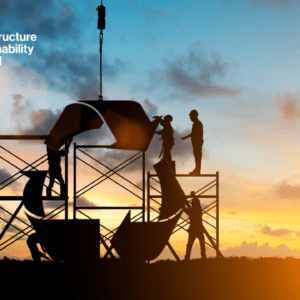As we approach the end of 2024, I would like to thank all of the Infrastructure Sustainability Council’s members for the ongoing support that you give to the ISC. While we as the ISC team welcome and are individually and collectively buoyed by that support, we are even more grateful for the positive impacts that you enable us to make in the market.
Regulations are tightening, expectations of sustainability performance are simultaneously increasing while also being challenged. It is a rather confused time. The lingering effects of inflation, cost of living and broader geo-politics are also squeezing budgets for infrastructure and construction. At the ISC, we will continue to focus on enhancing sustainability performance and encouraging ‘better business as usual’. The impacts of infrastructure – good and bad – exist well beyond the stretch of any single economic cycle.
At the same time, we have to be market sensitive and fit for purpose. As we come back in 2025, we will be enhancing our efforts to make our tools easier to use without losing their rigour. We will be releasing our new membership model, which will be at once simpler and have greater benefits for members. We are also energised by the pending launch of ISC’s Sustainability Academy, extending our well regarded training capabilities. We have also concluded strong work around our Theory of Change and that will flow into the ISC’s next five year plan, which we will be bringing to you for final input before its release, ready to run from 2025 – 2030.
On a personal note, thank you to everyone who has welcomed me so warmly into the role as ISC’s CEO. It is a tremendous privilege to lead this organisation and I look forward to repaying your enthusiasm with even better collective outcomes in the year – and years – ahead!
In the meantime, safe and happy holidays to all,
Toby
Industry Insights and Reflections from Australia, New Zealand and beyond
As 2025 approaches, there are 60 months to deliver substantial reductions in emissions to be on track for net zero and to deliver on global and national commitments to the UN Sustainable Development Goals. We are proud of the impact our members and partners have made in the last 12 months, and are equally aware of the need for urgent action and further step change in sustainable infrastructure policies and practices.
On the global stage, COP29, held in Baku, Azerbaijan, portrayed a mixed bag with some progress on Climate Finance and Carbon Markets, a strong call for more ambitious national emission reduction targets, little progress on adaptation and loss and damage, and no consensus on phasing out fossil fuels. Overall, COP29 absolutely reinforced the very urgent need for increased climate action and finance.
In Australia we have seen positive developments at a federal and state level on decarbonisation of infrastructure including the release of The Department of Climate Change, Energy, The Environment and Water’s Environmentally Sustainable Procurement (ESP) Policy and Reporting Framework, the Climate Change Authority’s Sector Pathway Review and (mainly cross-sectoral) recommendations, Infrastructure NSW’s Decarbonising Infrastructure Delivery Policy and accompanying Technical Guidance on Embodied Carbon Measurement for Infrastructure (now adopted nationally) and Infrastructure Victoria’s advice to the Victorian government on opportunities to reduce infrastructure-related greenhouse gas emissions. Infrastructure Australia also published guidance on valuing emissions for economic analysis, a critical aspect of infrastructure planning.
Infrastructure planning systems and processes is a key focus in Aotearoa New Zealand currently, with work underway on a 30-year National Infrastructure Plan to outline the country’s future infrastructure needs and planned investment, and a new national infrastructure authority, National Infrastructure Funding and Financing Limited (NIFFCo), established. Initial thinking underpinning the National Infrastructure Plan identifies pipeline certainty, decarbonisation, resilience and capability building amongst key challenges to be addressed. The ISC was excited to participate in stakeholder engagement sessions and prepare a submission for the plan development.
Global biodiversity loss has come under the spotlight in 2024 with a lot of activity in the Nature Positive and Natural Capital space. Early in the year, the United Kingdom in a global first, introduced mandatory biodiversity net gain (BNG) as a planning requirement. This pioneering framework aims to integrate biodiversity considerations into the planning process, setting a precedent for other countries to follow. In October, the first Global Nature Positive Summit Australia was hosted in Sydney, attended by over 1000 global leaders from around 50 countries, including environment and climate ministers, corporate leaders, and representatives from environmental groups and Indigenous communities. The summit underscored the importance of aligning nature-positive and net-zero objectives. We have also seen 24 Australian, and 1 New Zealand organisation adopt the Taskforce for Nature-related Financial Disclosures (TNFD) framework. The ISC continues to work with our members and stakeholders on highlighted natural capital assessment and reporting, nature-based solutions, and regenerative practices.




